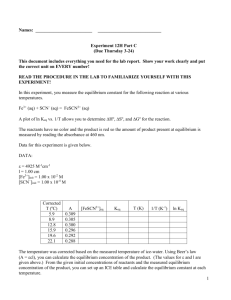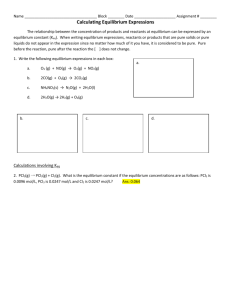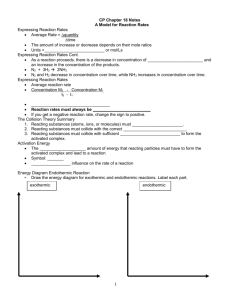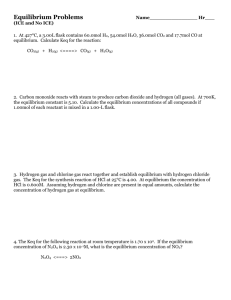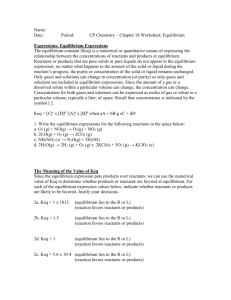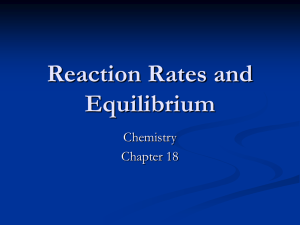Chapter 15 Chemical Equilibrium
advertisement
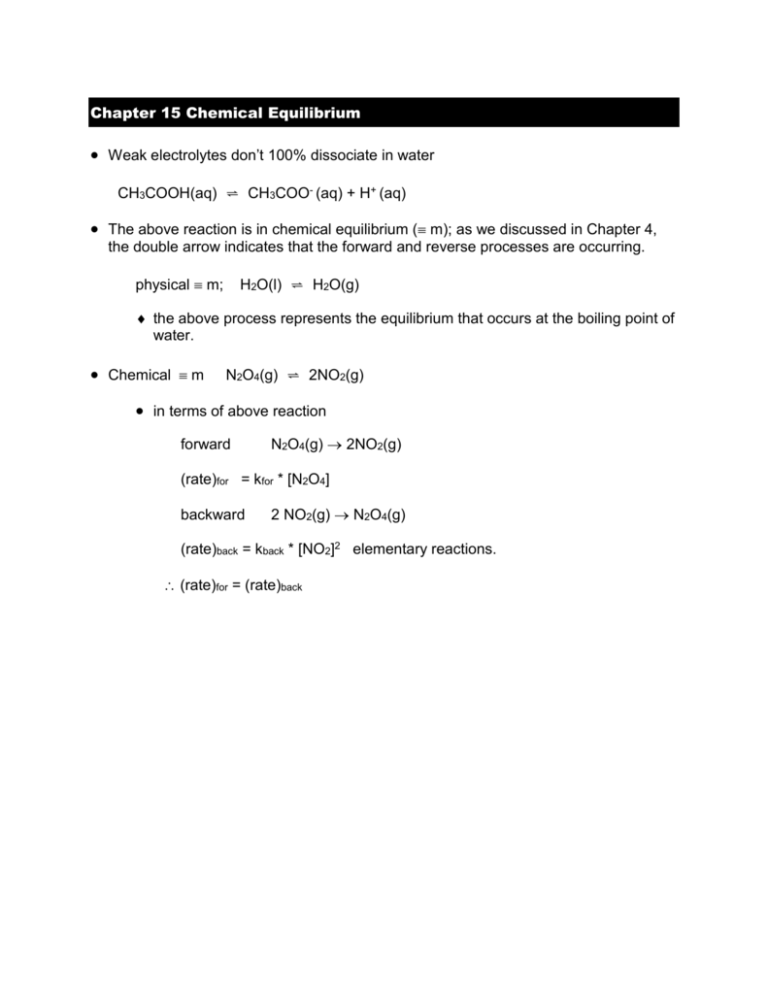
Chapter 15 Chemical Equilibrium Weak electrolytes don’t 100% dissociate in water CH3COOH(aq) ⇌ CH3COO- (aq) + H+ (aq) The above reaction is in chemical equilibrium ( m); as we discussed in Chapter 4, the double arrow indicates that the forward and reverse processes are occurring. H2O(l) ⇌ H2O(g) physical m; the above process represents the equilibrium that occurs at the boiling point of water. Chemical m N2O4(g) ⇌ 2NO2(g) in terms of above reaction forward N2O4(g) 2NO2(g) (rate)for = kfor * [N2O4] backward 2 NO2(g) N2O4(g) (rate)back = kback * [NO2]2 elementary reactions. (rate)for = (rate)back 2 [N2 O 4 ] k for = [NO 2 ]2 k back k [NO 2 ]2 = = for = K eq [N2 O 4 ] k back where K eq = the reaction equilibrium constant Alternatively look at the following data H2 (g) + I2 (g) 2HI (g) define K eq [HI]2 [H2 ][I2 ] [H2] [I2] [HI] [H2]eq [I2]eq [HI]eq 0.638 0.610 0.523 0.277 0.570 0.280 0.479 0.179 0 0 0 0 0.165 0.300 0.130 0.114 0.0978 0.0179 0.086 0.0165 0.945 0.540 0.786 0.326 Note: Keq = [HI]2/([I2] [H2]) is approximately constant while [HI]/ ([I2][H2]) can vary by quite a bit for any general reaction, aA + bB K eq ⇌ cC + dD [C]c [D]d [A]a [B]b also known as the law of mass action. [HI]eq ([I2][H2])eq 58.6 100.0 70.3 174 K 55.3 55.0 55.3 56.3 3 Examine the Magnitude of Keq 1. Keq is very large >> 1 e.g. 2 03(g) ⇌3 02(g) K = (PO2)3/(PO3)2 = 8.30 * 1010 Keq is large, the reactants side is much less favoured, i.e., reaction mixture at equilibrium contains primarily products. 2. Keq << 1 e.g. Cl2(g) ⇌2Cl(g) Keq = (PCl)2/ PCl2 = 4.3 * 10-37 at m, there will be a much greater amount of reactant than product in the m mixture. 3. Keq ~ 1 e.g. CO(g) + H2O(g) ⇌CO2 (g) + H2(g) K eq PH2 PC O2 PC OPH2O = 5.10; T = 830C the composition of the m mixture will be comparable as far as the concentration of products and reactants is concerned. Expressing Keq Homogeneous systems gas phase reaction 2 NO2(g) ⇌N2O4(g) we express the equilibrium constant in terms of the pressure of the reactants and products 4 Keq = (PNO2 )2/ PN2O4 PNO2 ; PN2O4 are the partial pressures of NO2 and N2O4, respectively. Heterogeneous Equilibria So far we have both with homogenous systems CaCO3 (s) ⇌CaO (s) + CO2 (g) Keq =PCO2 [CaO] / [CaCO3] but CaO and CaCO3 are pure solids we can treat their “concentration” as being constant Keq [Ca CO3] / [CaO] = PCO2 = Keq the m process depends on the partial pressure of CO2(g) only!!! Another example TiCl4 (l) + O2(g) ⇌TiO2(g) + 2Cl2(g) P TiO = 2 K eq C l2 2 [TiCl4 ]PO 2 TiO2(s) and TiCl4 (l) are pure substances, their molar concentration is constant K leq = K eq [TiCl4 ] [TiO2 ] P = 2 C l2 PO2 Why do we say that their “molar concentration” (solids and liquids) is constant? Mole / V density / molar mass 5 both are constants whether or not we have 1,3,5, 1000 g etc. Dissociation of a weak acid (or base) in water. NH3 (aq) + H2O (l) ⇌ NH4+ (aq) + OH- (aq) + [NH4 (aq)][ OH- (aq)] K eq = [NH3 (aq)][H2 O()] [H2O(l)] is essentially constant NH OH x [H O()] = + K eq 2 4 - NH3 K eq K b the base disociation constant . A similar constant can be defined for a weak acid, Ka acid dissociation 6 Equilibria for Multiple reactions. N2 (g) + O 2 (g) 2NO(g) (K eq )1 2 PNO = PN 2 PO 2 P = 2 2NO(g) + O 2 (g) 2 NO2 (g) overall N2 (g) + 202 (g) 2 NO2 (g) (K eq )2 (K eq NO2 PNO PO 2 2 P NO 2 )overall = PN 2 PO 2 but we notice PNO 2 2 PN 2 PO2 2 2 PNO 2 x PN 2 PO 2 PNO 2 * PO 2 2 PNO = (K eq ) ov erall = (K eq )1 x(K eq )2 => a general rule if a reaction can be expressed as the sum of one or more reactions, then the overall equilibrium constant is the product of the K1s of the individual reactions. Look at the following reaction N2O4 (g) ⇌ 2NO2(g) (Keq)1 = (PNO2)2/ PN2O4 turn it around 2 NO2(g) ⇌ N2O4(g) (Keq)2 = PN2O4/(PNO2)2 note (Keq)2 = 1/(Keq)1 if we reverse a reaction, the m constant for the reversed reaction is the inverse of the m constant in the originate direction Multiplying a reaction 7 N2O4 (g) ⇌ 2 NO2(g) (Kp)1 = (PNO2)2/ PN2O4 multiply reaction by 3 => 3N2O4(g) ⇌6NO2(g) (Keq)2 = (PNO2)6/(PN2O4)3 = ((PNO2)2/ PN2O4)3 Relationship between Chemical m and chemical kinetics We have already stated that within an equilibrium mixture, the microscopic recount, the forward and reverse i.e., the forward and reverse reactions occur at equal rates (note look at the “double arrow”). If we have an equilibrium constant, and the rate of either the forward or the reverse reaction, we can calculate the rate constant for the inverse process. Example Look at the reaction of 2NOCl(g) ⇌ 2NO(g) + Cl2(g) Examine both the forward and reverse reactions. 2NOCl(g) 2NO(g) + Cl2(g) Cl2 (g) + 2NO(g) 2NOCl(g) (rate)for = kfor (PNOCl)2 (rate)rev =krev (PNO)2PCl2 at m (rate)for =(rate)rev kfor (PNOCl)2 = krev (PNO)2PCl2 kfor / krev = (PNO)2PCl2/ (PNOCl)2 Keq VERY IMPORTANT FOR ELEMENTARY REACTIONS if the value of the m constant is known as well as a rate constant (where kfor or krev), the other rate constant may be easily found e.g. for the above reaction, Keq = 6.6 x 10-3 at 473 K 8 we are given kfor = 3.0 atm-1 s-1 calculate krev Keq = kfor / krev krev = kfor /Kc = 3.0 / 0.0066 = 456 krev = 4.6 * 10+2 atm-2 s-1 (note – equilibrium constants do not have units; rate constants have units that are dependent on the reaction type!!! We have to examine the individual reactions and their reaction types in order to affix the proper units for k in each situation!) What does the m constant tell us? We can predict the direction of a chemical reaction e.g. I2(g) + H2(g) ⇌ 2 HI (g) (PI2)o = 0.277 ; (PH2)o = 0.396; (PHI)o = 1.27 define Q the reaction quotient. Q PHI 2 PH2 PI 2 2 1.27 Q 0.3960.277 Q = 14.7 (note Keq = 55) Note a) Q< Keq => the ratio of the initial products is too small reactants must be converted to products b) (PI2)o = 0.026 ; (PH2)o = 0.117; (PHI)o = 1.98 2 1.98 Q 0.1170.026 9 Q > Keq some products will have to be converted to reactants as the ratio of products to reactants is too small c) Q = Keq the system is at m Handling m calculations Example The m constant for the following reaction, CO2(g) + H2(g) ⇌CO(g) + H2O(g) is equal to 0.11 at 700K. If we obtain the m partial pressures we find that we have 0.20 atm of both CO(g) and H2O(g) and 0.59 atm of CO2(g), calculate the partial pressure of H2(g). K eq = PC OPH2O PC O2 PH2 = 0.11 = (0.20)(0.20) (0.59)PH2 2 (0.20 ) => PH2 = 0.62 atm (0.59)(0.11) lets look at the following example Reaction 2NO2(g) N2O4(g) Keq = 0.154 at 373 K (PNO2)o = 0.267 atm Equilibrium Data Table Keq expression Start Change m Keq = PN2O4/(PNO2)2 PNO2 0.267 -2x 0.267-2x PN2O4 0 +x x 10 Keq = PN2O4/(PNO2)2 = [X]/[0.267-2x]2 0.154 * (0.267-2x)2 = x; 0.154 * (0.267-2x) (0.267-2x) = x 0.154 * (0.07129 -1.068 x + 4x2) = x 0.01098 – 0.1645 x + 0.616 x2 = x 0.01098 -1.1645 x + 0.616 x2 = 0 This is a quadratic equation; this can be solved using the quadratic formula. -b b - 4ac x= 2a For this particular equation a = 0.616; b = 1.1645; c = 0.01098 2 From the quadratic equation, we will obtain two roots. Root #1: x (1) = 1.881; Root #2: x (2) = 0.00948 Whenever we use the quadratic equation in a chemical equilibrium problem, we will find that one and only one root is a valid solution to the equilibrium problem (i.e., the other root gives us a solution that is physically meaningless). Which root would we choose in this case? (PNO2)eq = 0.267 - 2x If we use the value of Root #1 (PNO2)eq = 0.267 - 2 (1.881) < 0. This is an impossible situation. Therefore, we find that Root #1 is not acceptable!! Root #2 - x(2) = 0.00948 is the answer that makes physical sense. check (PNO2)eq = [0.267 - 2*(0.00948)] 11 = 0.248 atm (PN2O4)eq = 0.00948 When we substitute the equilibrium concentrations into the K expression, we obtain the following. Keq = PN2O4/(PNO2)2 = [0.00948]/[0.248]2 = 0.154 Another example N2(g) + 3H2(g) 2NH3(g) Keq = 4.31 * 10-4; T = 473K (PN2)o (g) = 1.214 atm (PH2)o = 0.526 atm Equilibrium Data Table K eq Keq expression PN2/atm 1.214 -x 1.214 - x Start Change m K eq PN2H3 PN2 PH32 PH2/atm 0.526 -3x 0.526 - 3x 2 PNH 3 PN2 PH32 PNH3/atm 0 +2x 2x 2x 2 4 3 4.1x10 = 1214 . x 0.526 3 x Note that this is a very complicated expression to solve. But we can simplify matters considerably!! note value of Keq <<<1 which indicates that the reaction mixtures is composed primarily of reactants at equilibrium. This indicates that x is very small. Therefore, we can assume the following. assume (1.214-x) 1.214 NOTE: IN PRACTICE, IF THE VALUE OF THE EQUILIBRIUM CONSTANT FOR THE REACTION IS, K < 0.0010 , AN ASSUMPTION MAY BE POSSIBLE. 12 We would also assume 0.526-3x 0.521 P 2 K eq (2x )2 NH3 PN2 PH32 = 1214 0.526 3 . 0.7615 * 10-4 = (2x)2 take the square root of both sides. 2x = 0.873 * 10-2 or x = 4.36 * 10-3 atm Check our assumptions 1.214 - 4.36 x 10-3 = 1.210 0.526 - 3 (4.36 x 10-3) = 0.513 this is a good approximation IF AND ONLY IF nX/ Initial pressure < 5% Check 4.36 x 10-3 / 1.214 * 100% = 0.359 % 3(4.36 x 10-3) / 0.526 * 100% = 0.0131/0.526 *100% = 2.51% Note: Both assumptions are valid; therefore, x = 0.00436 atm is a reasonable approximation to the amount of N2 (g) that reacts to form NH3 (g) at equilibrium. 13 Factors that Affect m m is a delicate balance. Note that we can change conditions such as [reactants]. reactants (or products), temp., pressure (external) and volume; how do these affect m. Le Chatelier’s Principle If a system in chemical m is subjected to an external stress, the system adjusts itself in such a way that the stress is relieved Concentration Changes e.g. FeSCN2+ (aq) Fe3+(aq) + SCN- (aq) red yellow colourless add Fe(NO3) (aq) to the equilibrium system, this will place a stress on the RHS of the reaction, and the equilibrium system will be pushed to the reactants side (i.e., there will be an increase in the red colour due to the increase in the concentration of the FeSCN2+ complex. add SCN- (aq) to the system as NaSCN (aq), we also see that the m shifts to left since the “stress” is on the right side of the reaction (similar to the Fe3+ (aq) addition above). Add a species that reacts strongly with Fe3+ (aq). (e.g. Na2C2O4(aq)). Na2C2O4 (aq) furnishes C2O42- (aq) ions which react strongly with the Fe3+ ion. Hence, this in effect removes Fe3+ from the equilibrium system. A stress is placed on the left hand side of the reaction, and more FeSCN2+ must dissociate to produce Fe3+ (the red colour fades). Change in Pressure or Volume 2NO2 ⇌ N2O4 K eq PN2O4 P 2 NO2 Increase external pressure => this favours the combination of 2NO2 to N2O4 since P(RHS) < P(LHS) for equal numbers of moles of gas; the reaction will go in the direction of the fewest number of moles of gas. 14 The effect of the stress on the equilibrium is dependent on the value of ng = n (gaseous products) - n(gaseous reactants). P ng + + - Direction of Shift to the left to the right to the right to the left What if (n (products) - n(reactants)) = 0? THERE IS NO EFFECT ON THE EQUILIBRIUM POSITION OF THE REACTION!! The same effects are observed for decreasing volumes of the container, since P 1/V decrease V and we increase P. What if we decrease the pressure for the above reaction? The reaction is now going to go in the direction of increasing number of moles of gas (the same effect is observed for an increase in volume since V means P) Can we change the pressure without changing the volume? If we add an inert gas (a gas that does not participate in the equilibrium reaction). The noble gases are good candidates (He, Ne, Ar etc.). e.g. 2NO2 (g) ⇌ N2O4 (g) P(RHS) < P(LHS) (V constant => n(RHS) <n(LHS)). If we add He to the system, we increase the total pressure, PT, but the partial pressures of the equilibrium gases PN204 and PNO2 don’t change. THERE IS NO EFFECT ON THE m POSITION ALTHOUGH WE WOULD THINK THERE WOULD BE ONE. Temperature Changes 2NO2(g) ⇌ N2O4(g) rxnH = -58.0 KJ the simplest way to attack this is to rewrite the reaction as follows 2NO2(g) ⇌ N2O4(g) + heat (i.e., heat is evolved) 15 when we increase T, we increase the “quantity of heat” (at const. V of course). the reaction is pushed to the left according to LeChatelier’s principle. What about the following? N2F4(g) ⇌ 2NF2(g) rxnH = 38.5kJ rxnH > 0 means heat is absorbed rewrite with heat on LHS of the reaction. heat + N2F4(g) ⇌ 2NF2(g) If we heat the reaction, the stress is placed on the LHS and according to the LeChatelier principle, the reaction m position would go from left to right (i.e. formation of NF2 is favoured). Catalysts => CATALYSTS SPEED UP RATES OF CHEMICAL REACTIONS! They have no effect on the position of an m. Why? C5H10 (g) + H2 (g) ⇌ C5H12(g) In the hydrogenation reaction, the catalyst (Pt) speeds up the rates of both the forward and reverse reactions equally. The m concentrations are achieved faster, but they are still the concentrations predicted by the m constant for the reaction!

